
The FSO Polonez is a motor vehicle that was developed in Poland in collaboration with Fiat and produced by Fabryka Samochodów Osobowych from 1978 to 2002. It was based on the Polski Fiat 125p platform with a new hatchback design by Zbigniew Watson, Walter de Silva and Giorgetto Giugiaro. It was available in body styles that included two- and four-door compact-sized cars, station wagons, as well as commercial versions as pickup truck, cargo van, and ambulance. Production totaled more than one million units, excluding the pickup truck and van variants. The Polonez was marketed in other nations and was popular in its domestic market until Poland joined the European Union in 2004.

The Autoblindo 40, 41 and 43 were Italian armoured cars produced by Fiat-Ansaldo and which saw service mainly during World War II. Most autoblinde were armed with a 20 mm Breda 35 autocannon and a coaxial 8 mm machine gun in a turret similar to the one fitted to the Fiat L6/40, and another hull mounted rear-facing 8 mm machine gun.

The L3/35 or Carro Veloce CV-35 was an Italian tankette that saw combat before and during World War II. Although designated a light tank by the Italian Army, its turretless configuration, weight and firepower make it closer to contemporary tankettes. It was the most numerous Italian armoured fighting vehicle and saw service almost everywhere the Italians fought in World War II but proved inadequate for modern warfare, having too thin armour and weak armament of only machine guns. It was cheaply produced but because of its light armaments and armour it was reserved to mostly colonial, policing, reconnaissance, and supply duties. However, given its low production costs, proved to be efficient in the Second Italo-Abyssinian War, Spanish Civil War and the Greco-Italian War where it provided reliable support to Italian infantry and disrupted enemy lines.

The Piaggio Porter is a cab over microvan and pick-up produced and sold by the Italian company Piaggio since 1992 under the Piaggio Commercial Vehicle brand.
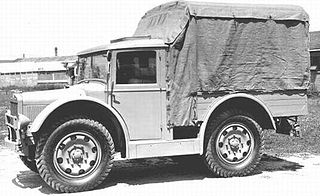
The SPA AS.37 was an Italian military light truck, used during World War II. The AS.37 Autocarro Sahariano was developed from 1937 on the frame of the TL.37 artillery tractor and was especially conceived to be employed in the North African desert. The most significant improvement of this new vehicle was its increased range: 900 km with added water tanks. The A.S.37 could transport 8 men and their equipment in its rear cargo box.

The TL.37 was an Italian military artillery tractor of World War II. It was manufactured by SPA, an Italian car maker that was a subsidiary of Fiat.
The Lancia Ro, Lancia Ro-Ro and Lancia 3Ro were 4x2 heavy trucks built by Italian manufacturer Lancia from the 1930s through the 1940s for military and civilian use. The 2-cylinder diesel Ro was produced from 1933 to 1939, the 3-cylinder diesel Ro-Ro from 1935 to 1939 and the improved 5-cylinder diesel 3Ro from 1938 to 1947.
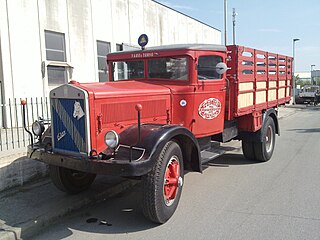
The FIAT 634N is the military variant of the civilian FIAT 632 heavy truck manufactured by Italian manufacturer FIAT from 1931 to 1939.

The Fiat 626 was an Italian medium truck that met specifications for the Italian army and air force for military operations prior to World War II. The Fiat 626 NLM operated in Italian North Africa (1940–1943), Italian East Africa (1940–1941), the Balkans (1940–1944), France (1940–1944), and Soviet Union (1941-1943/44).
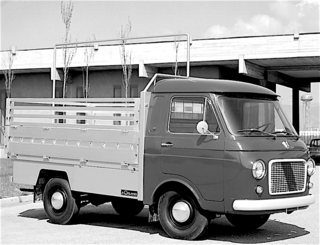
The Fiat 241 is a van produced by Fiat between 1965 and 1974. It has a payload over 1400 kg and was available in truck, van and bare chassis variants. The model was a replacement for the 1100T pickup which had ceased production in 1964.

The Auto-Saharan Companies were Italian military units specialised in long range patrols of the Sahara Desert. Companies were formed around expert soldiers, riding AB 41 armored cars and FIAT and Lancia light trucks customized to operate in the desert. The units operated from the late 1930s to the Italian surrender in 1943.
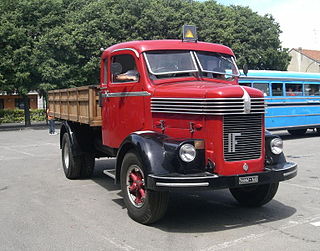
The Isotta Fraschini D80 is a large truck built in Italy from 1934 to 1955, the Isotta Fraschini D80 NM was built only in 1935.

Tanks have been employed by the military forces in Italy since their first use in World War I. They have had continued use in wars after and are still used through the modern day. The C1 Ariete is the current main battle tank of the Italian Army.
The Lancia 1Z was a light military truck produced by Italian manufacturer Lancia between 1912 and 1916. From a mechanical standpoint, it was closely related to the 1913 35 HP Theta passenger car. It was Lancia's first military vehicle.

The SPA 35 is an Italian light off-road truck vehicle produced in Italy by S.P.A. and used by the Royal Italian Army and the Regia Aeronautica during World War II and by the Italian Army in the postwar period. Dovunque is Italian for "anywhere" signifying that the vehicle is capable of travelling cross-country, "35" refers to the year of production.
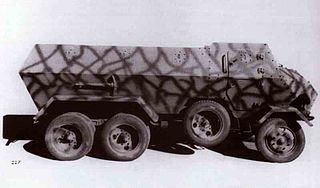
The SPA Dovunque 35 prottetto is a wheeled armored troop carrier, produced in Italy and employed by the Black Brigades of the Italian Social Republic during World War II.
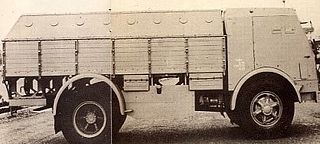
The Fiat 665NM protetto (protected) or scudato (shielded) was a wheeled armoured personnel carrier, produced in Italy and employed during World War II by the Royal Italian Army, the National Republican Army and the Wehrmacht.
Alfa Romeo A15 / A19 / A38 / F20 are a discontinued line of utility trucks, or lorries, produced by Alfa Romeo from 1967 to 1974.

The Fiat 619 is a multi-purpose truck, tractor for Semi-trailer trucks, manufactured from 1964 to 1980 and part of the Fiat V.I. family of heavy vehicles. The truck was intended to replace the Fiat 682 in production since 1952, but the manufacturing of the latter continued until 1984, also thanks to the demands of the African market.


















